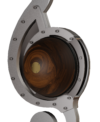Technical
Time is of the Essence

The step response of a loudspeaker is an expression of how well it can reproduce a sudden and sharp transient in amplitude across the audible frequency range. As a note is first struck, an initial short complex burst of mixed frequency energy occurs making time coherence essential for perceiving an instrument as authentic.

The thin steep vertical brown line represents the TCA-M step response of a 10Hz – 24KHz frequency sweep. There is just 0.05ms between each vertical gridline and thus the TCA-M step response transition occurs in less than 0.1 milliseconds.
The shape of an ideal step response is a right-angled triangle, which is achieved by the TCA-M loudspeaker as well as practically possible within the physical constraints of modern electro acoustics. An attack of a piano key will, like in real life, be physically felt adding authentic distinctive punch to the experience.
Psychoacoustics of transients and identifying sounds
It turns out that frequency response does not sufficiently describe the qualities that enables us to identify instruments or other sounds we easily recognise.
"We now know that we normally identify what instrument is being played, almost entirely by starting transients, the complex patterns of rapidly changing sounds at the beginning of notes. That surprises some people; it is contrary to popular — and Helmholtzian — belief. But that is how we identify all natural sounds, noises and words, by transient pattern changes.
In general, one cannot get any orthodox instrument to produce sound without giving it a 'kick’; even the most gentle start to a sound is a transient. Pickering (1989) showed that it can take a fifth of a second or more for a violin string to settle down to steady vibration, and much depends on how the note is started (Beament, 1997). And the change from one pitch to another is a transient, however legato the music is played. Percussive sound, including that of pianos, is entirely transient.
A recording of a piano or guitar played backwards is unrecognisable. If we make magnetic tape recordings of people playing normal steady-pitched notes, and then remove the starting transients of the notes, the first fifth of a second or less, it is difficult to identify what instrument was responsible for the sound. We are not used to identifying instruments by the steady-pitched sound which follows the transient, and if we splice the starting transient of one instrument onto the continuing sound of another instrument we can be confused, identify the instrument by the transient and think it has rather odd tone.
If an instrumentalist plays more than half a dozen notes per second, the sound consists entirely of starting transients. We can identify the instrument from these transients, and we can discern pitches, because there is sufficient steadily repeating vibration in the transients. But transients have no regular pattern of sizes of their harmonics, and random noise is also present[1]".
[1] How We Hear Music: The Relationship Between Music and the Hearing Mechanism, By James Beament

Conventional loudspeaker design step and transient response
A conventional audio system consisting of a multi-way loudspeaker with a passive crossover presenting a variable load to an external power amplifier, is unlikely to be phase linear. Consequently an ideal step response is not possible, as seen in the example above, and results in some amount of variable group delay increasing at low frequencies and a related relatively poor transient response.
For example, a hit on a snare drum or piano key will not sound authentic since the complex pattern of frequencies starting every note, the harmonics and fundamental tone are not time coherent.
The TCA-M loudspeaker achieves both perfect acoustic time-alignment, constant group delay and an ideal frequency response all managed in the digital domain.
The TCA-M loudspeaker acoustic measured group delay, as shown below, is constant from 30Hz – 20KHz, slightly increasing from 30Hz down towards 20Hz by 13ms, unique to our patented acoustic platform.


Group delay and phase-linearity
Group Delay refers to some frequencies arriving from a loudspeaker system at the ears later than others, even when each frequency travelled the exact same distance.
With a well-designed loudspeaker system group delay should not occur, but to some extent invariably it does with conventional designs. This is because in practice designing a high-quality loudspeaker requires distributing the low and higher frequencies of the audible range across multiple, and usually physically separate loudspeaker drivers, each optimised for a certain range of frequencies.
Non-linear phase characteristics is to varying degrees an unavoidable problem with conventional passive loudspeaker designs, where there is a trade-off between a flat frequency response or phase linearity.
Exceeding audible levels of group delay is perceived as ‘smearing’, ‘thin’, ‘imprecise’ and ‘slightly detuned’ affecting the natural sound characteristics of instruments, voices and even low frequency instruments and ambient sounds captured in the original recording.
To learn more, please download our “Room Acoustics, Psychoacoustics and TCA-M Design Concepts” white paper and the Features and Technical Specification.


